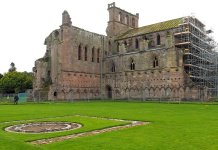Melrose lies between the banks of the River Tweed and the triple peaks of the Eildon Hills, The Romans had a major fort nearby known as Trimontium, although all that is left are crop marks on the ground.
There is nothing left either of the C6th abbey founded by St Aidan, bringing monks from Iona. St Cuthbert was a monk here having seen a vision whilst looking after sheep on the Lammermuir Hills. Melrose Abbey dates from the C12th and settlement grew up round it.

Being on the Border, it was in the path of invading English armies, and attacked several times. In the mid C16th it was an established wool and linen producing centre, although it was never as important as other local towns.
It is still an important local centre with a good range of shops and is also popular with toourists. . The town centre has the advantage of being bypassed by the A6019 which runs along the line of the old railway past the old station building, immediately to the south of the town. Heavy traffic is kept away from the centre.

There is a map of the towm here and a town trail.
The Mercat cross is in the market place overlooked by the former red sandstone town hall building.


Across the road is the Ormiston Institute which was built in 1882 and bequeathed to the town by Charles Ormiston. It now houses the Trimontium Museum. The clock is dated 1892 and dedicated to the physician and surgeon John Meilke, erected by grateful patients.


High Street drops down from the Market Place and is the main shopping area with small locally owned shops.

Melrose has a strong tradition of rugby and the Melrose Sevens has been a regular spring time event since 1883.
Melrose has two very attractive small gardens owned by the National Trust for Scotland. Priorwood Garden is a walled garden next to Melrose Abbey. There is a wide herbaceous border which was used for cut flowers for drying and preservation. It also has a n orchard growing over 70 different types of apples. These are for sale from a small honesty kiosk.



Harmony Garden is a few yards away across Abbey Street from the Abbey. These were the gardens of Harmony House, a splendid Georgian building built from the proceeds of a lime and pimento platation in Jamaica. This is now a holiday let.

There is a large grassed area in front of the house which is covered with flowering bulbs in the spring with shrubs and trees.

Around the house are the ornamental gardens with herbaceous borders.


It also has a kitchen garden with greenhouse and raised beds for growing vegetables.

cont...
There is nothing left either of the C6th abbey founded by St Aidan, bringing monks from Iona. St Cuthbert was a monk here having seen a vision whilst looking after sheep on the Lammermuir Hills. Melrose Abbey dates from the C12th and settlement grew up round it.
Being on the Border, it was in the path of invading English armies, and attacked several times. In the mid C16th it was an established wool and linen producing centre, although it was never as important as other local towns.
It is still an important local centre with a good range of shops and is also popular with toourists. . The town centre has the advantage of being bypassed by the A6019 which runs along the line of the old railway past the old station building, immediately to the south of the town. Heavy traffic is kept away from the centre.
There is a map of the towm here and a town trail.
The Mercat cross is in the market place overlooked by the former red sandstone town hall building.
Across the road is the Ormiston Institute which was built in 1882 and bequeathed to the town by Charles Ormiston. It now houses the Trimontium Museum. The clock is dated 1892 and dedicated to the physician and surgeon John Meilke, erected by grateful patients.
High Street drops down from the Market Place and is the main shopping area with small locally owned shops.
Melrose has a strong tradition of rugby and the Melrose Sevens has been a regular spring time event since 1883.
Melrose has two very attractive small gardens owned by the National Trust for Scotland. Priorwood Garden is a walled garden next to Melrose Abbey. There is a wide herbaceous border which was used for cut flowers for drying and preservation. It also has a n orchard growing over 70 different types of apples. These are for sale from a small honesty kiosk.
Harmony Garden is a few yards away across Abbey Street from the Abbey. These were the gardens of Harmony House, a splendid Georgian building built from the proceeds of a lime and pimento platation in Jamaica. This is now a holiday let.
There is a large grassed area in front of the house which is covered with flowering bulbs in the spring with shrubs and trees.
Around the house are the ornamental gardens with herbaceous borders.
It also has a kitchen garden with greenhouse and raised beds for growing vegetables.
cont...

